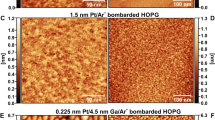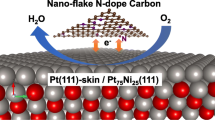Abstract
The formation of Pt clusters deposited by strong electrostatic adsorption (SEA) has been studied on highly oriented pyrolytic graphite (HOPG) as well as on higher surface area graphene nanoplatelets (GNPs), which have well-defined surface structures. Both surfaces can be hydroxylated by treatment with hydrochloric acid, and in the case of HOPG, the surface functional groups are exclusively hydroxyls. When SEA is carried out with the anionic precursor PtCl6 2− under acidic conditions, the dominant cationic sites for electrostatic adsorption are protonated aromatic rings rather than protonated hydroxyl groups, and therefore the unfunctionalized surfaces exhibit high uptake compared to the HCl-treated surfaces. In contrast, for SEA with the cationic precursor Pt(NH3)4 2+ under basic conditions, surface hydroxylation leads to higher Pt uptake since deprotonated hydroxyl groups act as negatively charged adsorption sites for the cations. After reduction of the adsorbed ionic precursors by heating in H2, the metallic Pt clusters on HOPG produced from PtCl6 2− SEA form dendritic aggregates associated with high Pt diffusion rates and irreversible Pt–Pt bonding. For Pt(NH3)4 2+ SEA on HOPG, subsequent reduction resulted in clusters preferentially located at step edges on the untreated surface, whereas smaller clusters more uniformly distributed across the terraces were observed on the hydroxylated surface. Similar trends in particle sizes and densities were observed on the GNP surfaces, demonstrating that understanding of nucleation and growth on single-crystal HOPG surfaces can be extended to the high surface area GNPs. Oxidative adsorption to Pt4+ was observed for SEA of Pt2+ precursors on both HOPG and GNP surfaces.








Similar content being viewed by others
References
Regalbuto JR (2007) Strong electrostatic adsorption of metals onto catalyst supports In: Regalbuto JR (ed) Catalyst preparation: science and engineering. Taylor and Francis, Boca Raton
Regalbuto JR (2006) A scientific method to prepare supported metal catalysts In: Richards R (ed) Surface and nanomolecular catalysis. CRC Press, Boca Raton
Hao X, Barnes S, Regalbuto JR (2011) A fundamental study of Pt impregnation of carbon: adsorption equilibrium and particle synthesis. J Catal 279:48–65
Cameron DS, Cooper SJ, Dodgson IL, Harrison B, Jenkins JW (1990) Carbon as supports for precious metal catalysts. Catal Today 7:113–137
Radovic LR, Rodriguez-Reinoso F (1997) Carbon materials in catalysis In: Thrower PA (ed) Chemistry and physics of carbon. vol 25. Marcel Dekker, New York
Rodriguez-Reinoso F (1998) The role of carbon materials in heterogeneous catalysis. Carbon 36:159–175
Rodriguez-Reinoso F (1995) In: Patrick JW (ed) Porosity in carbons. Wiley, Chichester
Auer E, Freund A, Pietsch J, Tacke T (1998) Carbons as supports for industrial precious metal catalysts. Appl Catal A 173:259–271
Coloma F, Sepulveda-Escribano A, Fierro JLG, Rodriguez-Reinoso F (1997) Gas phase hydrogenation of crotonaldehyde over Pt/activated carbon catalysts. Influence of the oxygen surface groups on the support. Appl Catal A 150:165–183
Job N, Pereira MFR, Lambert S, Cabiac A, Delahay G, Colomer JF, Marien J, Figueiredo JL, Pirard JP (2006) Highly dispersed platinum catalysts prepared by impregnation of texture-tailored carbon xerogels. J Catal 240:160–171
Gasteiger HA, Gu W, Makharia R, Mathias MF, Sompalli B (eds) (2003) Handbook of fuel cells: fundamentals, technology and applications. Wiley, Chichester
Antolini E (2009) Carbon supports for low-temperature fuel cell catalysts. Appl Catal B 88:1–24
Lee EK, Park SA, Woo H, Park KH, Kang DW, Lim H, Kim YT (2017) Platinum single atoms dispersed on carbon nanotubes as reusable catalyst for Suzuki coupling reaction. J Catal 352:388–393
Raciti D, Kubal J, Ma C, Barclay M, Gonzalez M, Chi MF, Greeley J, More KL, Wang C (2016) Pt3Re alloy nanoparticles as electrocatalysts for the oxygen reduction reaction. Nano Energy 20:202–211
Duke AS, Dolgopolova EA, Galhenage RP, Ammal SC, Heyden A, Smith MD, Chen DA, Shustova NB (2015) Active sites in copper-based metal organic frameworks: understanding substrate dynamics, redox processes, and valence band structure. J Phys Chem C 119:27457–27466
Wagner CD, Riggs WM, Davis LE, Moulder JF (1979) Handbook of X-ray photoelectron spectroscopy. Perkin-Elmer, Eden Prairie
Chalmers JM (2002) Mid-infrared spectroscopy: anomalies, artifacts and common errors In: Chalmers JM, Griffiths PR (eds) Handbook of vibrational spectroscopy. Wiley, Chichester
Peuckert M, Coenen FP, Bonzel HP (1984) XPS study of the electrochemical surface oxidation of platinum in 1N H2SO4 acid electrolyte. Electrochim Acta 29:1305–1314
Battistoni C, Giuliani AM, Paparazzo E, Tarli F (1984) Platinum complexes of the methyl-esters of dithiocarbazic acid and 3-phenyldithiocarbazic acid. J Chem Soc Dalton Trans 7:1293–1299
Buono C, Davies PR, Davies RJ, Jones T, Kulhavy J, Lewis R, Morgan DJ, Robinson N, Willock DJ (2014) Spectroscopic and atomic force studies of the functionalisation of carbon surfaces: new insights into the role of the surface topography and specific chemical states. Faraday Discuss 173:257–272
Burgess R, Buono C, Davies PR, Davies RJ, Legge T, Lai A, Lewis R, Morgan DJ, Robinson N, Willock DJ (2015) The functionalisation of graphite surfaces with nitric acid: identification of functional groups and their effects on gold deposition. J Catal 323:10–18
van Dam HE, van Bekkum H (1991) Preparation of platinum on activated carbon. J Catal 131:335–349
Vickerman JC (ed, 1997) Surface analysis: the principal techniques. Wiley, New York
Hao X, Quach L, Korah J, Spieker WA, Regalbuto JR (2004) The control of platinum impregnation by PZC alteration of oxides and carbon. J Mol Catal A 219:97–107
Hao X (2004) On the science of catalyst preparation: platinum impregnation over carbon. Ph.D. Thesis, University of Illinois Chicago
Leon C, Solar JM, Calemma V, Radovic LR (1992) Evidence for the protonation of basal plane sites on carbon. Carbon 30:797–811
Yu AP, Ramesh P, Itkis ME, Bekyarova E, Haddon RC (2007) Graphite nanoplatelet-epoxy composite thermal interface materials. J Phys Chem C 111:7565–7569
Ramesh P, Sampath S (2003) Electrochemical characterization of binderless, recompressed exfoliated graphite electrodes: electron-transfer kinetics and diffusion characteristics. Anal Chem 75:6949–6957
Bouleghlimat E, Davies PR, Davies RJ, Howarth R, Kulhavy J, Morgan DJ (2013) The effect of acid treatment on the surface chemistry and topography of graphite. Carbon 61:124–133
Kalinkin AV, Sorokin AM, Smirnov MY, Bukhtiyarov VI (2014) Size effect in the oxidation of platinum nanoparticles on graphite with nitrogen dioxide: an XPS and STM study. Kinet Catal 55:354–360
Howells AR, Hung L, Chottiner GS, Scherson DA (2002) Effects of substrate defect density and annealing temperature on the nature of Pt clusters vapor deposited on the basal plane of highly oriented pyrolytic graphite. Solid State Ionics 150:53–62
Yuan Z, Hanf MC, Stephan R, Dulot F, Denys E, Florentin A, Harbich W, Wetzel P (2015) Growth of palladium nanoparticles on nanostructured highly ordered pyrolytic graphite. Surf Interface Anal 47:82–86
Blum B, Salvarezza RC, Arvia AJ (1999) Vapor-deposited gold film formation on highly oriented pyrolitic graphite. A transition from pseudo-two-dimensional branched island growth to continuous film formation. J Vac Sci Technol B 17:2431–2438
Hwang RQ, Bartelt MC (1997) Scanning tunneling microscopy studies of metal on metal epitaxy. Chem Rev 97:1063–1082
Hwang RQ, Schroder J, Gunther C, Behm RJ (1991) Fractal growth of 2-dimensional islands: Au on Ru(0001). Phys Rev Lett 67:3279–3282
Peuckert M, Bonzel HP (1984) Characterization of oxidized platinum surfaces by X-ray photoelectron spectroscopy. Surf Sci 145:239–259
Legare P, Hilaire L, Maire G (1984) Interaction of polycrystalline platinum and a platinum silicon alloy with oxygen—an XPS study. Surf Sci 141:604–616
Witten TA, Sander LM (1981) Diffusion-limited aggregation, a kinetic critical phenomenon. Phys Rev Lett 47:1400–1403
Meakin P, Witten TA (1983) Growing interface in diffusion-limited aggregation. Phys Rev A 28:2985–2989
Galhenage RP, Xie K, Diao W, Tengco JMM, Seuser GS, Monnier JR, Chen DA (2015) Platinum-ruthenium bimetallic clusters on graphite: a comparison of vapor deposition and electroless deposition methods. Phys Chem Chem Phys 17:28354–28363
Lee HBR, Bent SF (2015) Formation of continuous Pt films on the graphite surface by atomic layer deposition with reactive O3. Chem Mater 27:6802–6809
Weast RC (ed) (1989–1990) CRC handbook of chemistry and physics, 70th edn. CRC Press, Inc., Boca Raton
Acknowledgements
We gratefully acknowledge financial support from the National Science Foundation Industry/University Collaborative Research Center Grant (IIP 1464595) and the National Science Foundation (CHE 1300227). G.S.S. and A.J.B. also acknowledge support from a National Science Foundation IGERT Grant (DGE 1250052).
Author information
Authors and Affiliations
Corresponding author
Electronic supplementary material
Below is the link to the electronic supplementary material.
Rights and permissions
About this article
Cite this article
Seuser, G.S., Banerjee, R., Metavarayuth, K. et al. Understanding Uptake of Pt Precursors During Strong Electrostatic Adsorption on Single-Crystal Carbon Surfaces. Top Catal 61, 379–388 (2018). https://doi.org/10.1007/s11244-017-0872-3
Published:
Issue Date:
DOI: https://doi.org/10.1007/s11244-017-0872-3




